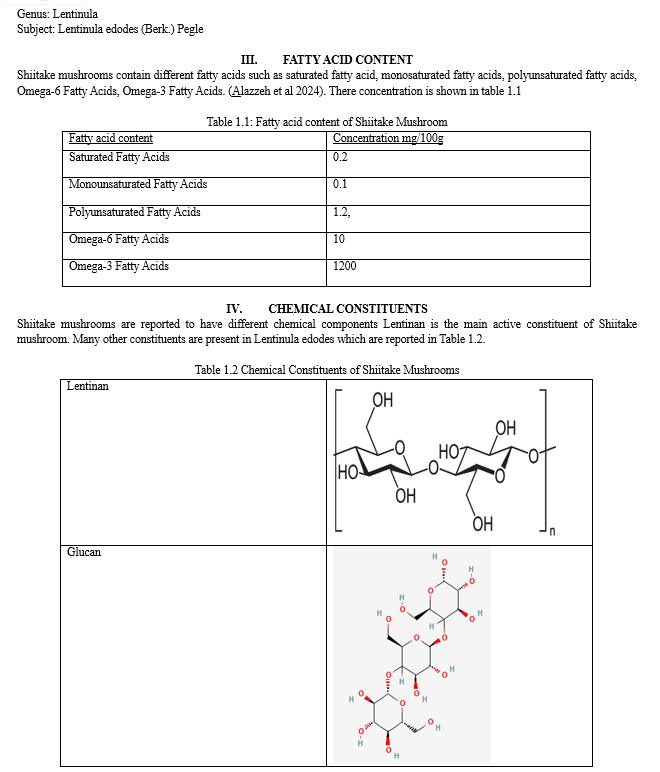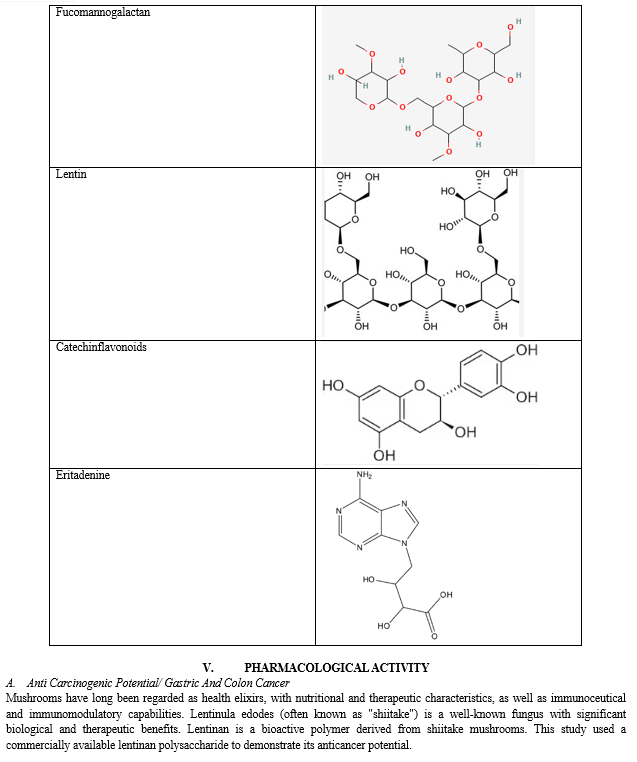Ijraset Journal For Research in Applied Science and Engineering Technology
- Home / Ijraset
- On This Page
- Abstract
- Introduction
- Conclusion
- References
- Copyright
“Unlocking the Therapeutic Potential: A Comprehensive Review of the Pharmacological Activities of Shiitake Mushroom (Lentinula edodes)
Authors: Reema Rani, Tushar Rajguru, Neha Pawar, Aarti Labhane, Dr. Rupali Tasgaonkar, Satyam Prajapati, Tushar Patil
DOI Link: https://doi.org/10.22214/ijraset.2024.59301
Certificate: View Certificate
Abstract
Worldwide, edible mushrooms are prized for their medical and nutraceutical qualities. Because of their high protein content, low fat and cholesterol levels, low-calorie content, and abundance of vital vitamins, they are acknowledged as the new superfood of the future. This is considered that mushrooms are the only vegetarian source of vitamin D because they contain high amount of ergosterol and fat-soluble vitamins. Limited information exists regarding the composition and amount of fiber, although polysaccharides such as ?-glucans increase the nutritional value of mushrooms. Mushrooms are a fantastic food because of their many pharmacological and nutraceutical qualities, as has been noted. Shiitake mushrooms are nutrient-dense, widely farmed fungal plants and possess various pharmacological and nutraceutical properties. The purpose of this review is to compile the most recent information on the health advantages and medicinal uses of shiitake mushrooms.
Introduction
I. INTRODUCTION
Mushrooms are macrofungi from the phylum Basidiomycota that are typically consumed as food (Mowna Sundari et al., 2018). According to estimates, there are over 140,000 mushroom species in nature, but only 2000 of them are edible, and only about 25 of them (Agaricus bisporus, Pleurotus ostreatus, Lentinus edodes, Cordyceps militaris, Hericium erinaceus, Volvariella volvacea, Ganoderma lucidum, Auricularia spp., etc.) are commercially available as food products (Heleno et al., 2009; Rathore et al., 2017). Mushrooms are considered a nutritious and low-calorie food source due to their high protein, fat, mineral, and vitamin content (Hamza et al,2024).
Shiitake mushroom (Lentinus edodes) is the second-largest edible mushroom that has experienced increased growth in terms of production and usage over the past few years (Salwan et al., 2021). They provide nutrition to consumers, as well as the benefits are multifaceted. There are numerous reports regarding the nutritional and health benefits of shiitake mushrooms, which range from improving health to preventing diseases (Ahmad et al 2023).
Its medicinal extracts are commonly utilized in traditional Chinese medicine to treat a variety of ailments. A vast number of pharmacological and clinical investigations have demonstrated that lentinan (LNT), one of the active shiitake mushroom extracts, possesses antioxidant, immunomodulatory, anti-tumor, anti-cancer, hypoglycemic, hypolipidemic, and other biological properties. (Zhou et al 2024). This review particularly focuses on the nutraceutical properties of the shiitake mushroom.



The results demonstrated lentinan's anti-cancer cell proliferation action on colon and stomach cancer cell lines by inhibiting the G2/M phase of the cell cycle. Lentinan might also inhibit wound healing, colony formation, and migration in AGS and HT-29 cells, indicating cancer potential. Lentinan may enhance phosphor-p38 and reduce phosphor-ERK1/2, the Mu-2-related death-inducing gene (MuD) protein. Lentinan also increased the generation of reactive oxygen species (ROS), which was directly linked to cell death. This study proved numerous elements of lentinan's anticarcinogenic effect, including its influence on MuD. This is the first evidence of cross-talk between lentinan and MuD protein, demonstrating lentinan's anti-apoptotic effect (Park et al 2024).
B. Hypo-Cholesterolemic Agents
Hypercholesterolemia, low-density lipophilic oxidation, and atherosclerosis all have been associated with cardiovascular diseases. Therefore, blood cholesterol levels must be managed for the prevention and treatment of this disease. Edible mushrooms are the finest food for preventing heart problems due to their low fat and high fiber content. Eating edible mushrooms is a natural hypocholesterolemia and anti-sclerotic diet that is widely advocated in oriental medicine (Ishikawa et al.,1986). Rathee et al. 2012 isolated and identified the active hypocholesterolemic component eritadenine [2(R), 3(R)-dihydroxy-4-(9-adenyl)-butyric acid] in the shiitake mushroom. Eritadenine can lower serum cholesterol levels in mice by speeding up the removal of ingested cholesterol and its metabolic disintegration.
C. Hepatoprotective Effects
Oxidative stress is the primary cause of liver damage, which manifests as fibrosis, chronic hepatitis, hepatocellular cancer, and cirrhosis. Hepatotoxicity is an injury to the liver that results in reduced liver function and can be caused by the consumption of any medicine or non-infectious substance. Extracts from Lentinus edodes basidiomass (100 mg/kg body weight) significantly reduced paracetamol-induced alanine transaminase and aspartate transaminase levels. (Kumar et al 2021)
D. Anti-Microbial Assay
All of the mushrooms implemented in this investigation were shown to have varying degrees of antibacterial activity against the tested microorganisms. Extracts with a zone of inhibition larger than 10 millimeters were regarded as exceedingly active. L. edodes (17 ± 0.2 mm) demonstrated the antibacterial activity against Bacillus subtilis in vitro. It also shows the antibacterial action of L. edodes against B. cereus, S. aureus, and E.coli. Komemushi et al. (1996) also reported that L. edodes inhibited the proliferation of Gram-positive and Gram-negative bacteria..
E. Antioxidantal
Candida albicans and Saccharomyces cerevisiae were shown to be highly sensitive in comparison to positive controls. Pseudomonas aeruginosa had more resistance to mushroom extract than other isolates. Pseudomonas aeruginosa had a high MIC with all mushroom extracts. Lentinula edodes had low MICs against all isolates, unlike others. Candida albicans and Saccharomyces cerevisiae demonstrated the lowest MIC against Lentinula edodes and reported a similar finding. (Chowdhury et al, 2015)
F. Anti-Thrombotic Effects
Antithrombotic Effects Individuals who consume Shiitake mushroom oil are considerably less likely to get thrombosis. The Department of Agricultural and Biological Chemistry at Nihon University in Japan discovered that the amounts of methionine in shiitake mushrooms suppress platelet aggregation.
G. Antihypertensive Effects
antihypertensive effects High blood pressure causes your heart to work harder and, if left untreated, can result in a stroke or heart attack. Preliminary research suggests that eating shiitake and other types of mushrooms may help prevent blood pressure rises. Antiobesity Effects Shiitake mushrooms have several health benefits, including the capacity to help people lose weight. According to the American Heart Association (47), having a well-balanced diet rich in these nutritional mushrooms is the most effective method to lose and maintain weight. In your quest for weight reduction success, make sure to cook the mushrooms in a low-fat, heart-healthy way.
H. Anti-Obesity Effects
L.edodes is high in vital elements and is considered a potential source of amazing biological characteristics. However, this study looked at the potential bioactive compounds of L. edodes and how they interact with obesity-related genes. The findings show that L. edodes may help alleviate the symptoms of obesity because it contains chemicals that break down lipids. Furthermore, network pharmacology can be widely applied to anticipate bioactive chemicals and gene targets for disease treatment. Following that, an in-vitro cell-based experiment was performed to validate the network pharmacology results, and it was discovered that the aqueous extract of L. edodes showed less lipid accumulation and a higher adiponectin level, indicating its potential use in obesity regulation. Future research aims to isolate and identify the mycocompounds responsible for the anti-obesity effects. (Kaur et al 2024)
I. Osteoprotective Effects
In vitro and animal studies have both shown osteoprotective benefits. They influence both bone-building osteoblasts and bone-degrading osteoclasts. An aqueous extract of Lentinula edodes fruit bodies (<30 µg/mL) increased ALP activity and mineralization in two human osteoblastic cell lines (HOS 58 and SaOS-2) [65]. Similar effects and an increase in osteocalcin synthesis were observed in the mouse osteoblast cell line MC3T3-E1 and primary rat osteoblasts. Rat osteoclasts' ability to reduce bone mass was blocked [66].
In another study, a water extract and its subsequent ethyl acetate fraction inhibited the development of bone marrow-derived macrophages from mice into osteoclasts. The fraction (10 µg/mL) reduced RANKL-induced osteoclast differentiation by inhibiting NFATc1. Comparative transcriptome analysis demonstrated that the fraction downregulated several RANKL-associated target genes, including Nfatc1, and blocked their expression. In a zebrafish model of glucocorticoid-induced osteoporosis, the fraction restored an osteoporotic phenotype.
J. Cosmetics
An ethanolic extract with polyphenols and β-glucan reduces MMP-1 and MMP-9 expression while increasing type I procollagen expression in UVA- and UVB-irradiated HaCaT keratinocytes. The findings suggest that L. edodes could be used as a cosmetic material to prevent UV-induced skin aging [77].
In another study, an ethanolic extract of L. edodes and a cosmetic cream formulation containing the extract reduced the production of the inflammatory mediator nitric oxide (NO) by LPS-stimulated macrophages, demonstrating anti-inflammatory action. Furthermore, both the extracts and the cream had antibacterial properties against Enterococcus faecalis and methicillin-sensitive and methicillin-resistant Staphylococcus aureus.
VI. TOXICITY
Linear flagellated dermatitis (shiitake dermatitis), pruritus, fever, diarrhea, and mucosal ulcers are common side effects of eating raw or uncooked mushrooms. They are attributed to lentinan. In this instance, it is vital to avoid coming into touch with or eating shiitake mushrooms. Its high insoluble fiber content may make digestion difficult. When large chunks of mushroom are consumed, this can cause luminal blockage. There have been reports of intestinal obstruction caused by the consumption of shiitake mushrooms that necessitated surgical intervention. (Lindequist et al 2024)
Conclusion
Mushrooms, a type of macrofungus, are considered a nutritious and low-calorie food source due to their high protein, fat, mineral, and vitamin content. Lentinus edodes, the second-largest edible mushroom, has experienced increased growth in terms of production and usage over the past few years. Shiitake mushrooms, the second largest eatable mushroom, are gaining fame due to their nutritional value and possible use in traditional Chinese medicine. They contain lentinan, which has anti-inflammatory, and anti-inflammatory effects. Edible mushrooms, with their low fat and high protein content, can be used in low-calorie and high-protein diets and can help avoid lifestyle diseases like diabetes, hypertension, cancer, and cardiovascular disease. However, the extraction of secondary metabolites from edible mushrooms remains a big research focus. Shiitake mushrooms have various pharmacological properties which are used to cure human and animal diseases. Shiitake mushrooms are used as an anti-cancer agent for colon and Gastric cancer, Hypo-Cholesterolemic Agent, hepatoprotective agent, antimicrobial agent, antioxidant agent, antihypertensive agent, anti-obesity agent, anti-viral agents are also used as a cosmetic agent.
References
[1] Ahmad, I., Arif, M., Xu, M., Zhang, J., Ding, Y., & Lyu, F. (2023). Therapeutic values and nutraceutical properties of shiitake mushroom (Lentinula edodes): A review. Trends in Food Science & Technology, 134, 123-135. [2] Alazzeh, A. Y., Khalifa, A. M., Khatoon, F., Khan, F. H., ALmughais, E. S., Shommo, S. A., ... & Alshammari, F. M. (2024). Nutrition Value of Mushroom Intake And Its Impact On Human Health. International Neurourology Journal, 28(1), 12-17. [3] Chowdhury M.M.H., Kubra K., Ahmed S.R. Screening of antimicrobial, antioxidant properties and bioactive compounds of some edible mushrooms cultivated in Bangladesh. Ann. Clin. Microbiol. Antimicrob. 2015;14:1–6. doi: 10.1186/s12941-015-00673. [4] Hamza, A., Mylarapu, A., Krishna, K. V., & Kumar, D. S. (2024). An insight into the nutritional and medicinal value of edible mushrooms: A natural treasury for human health. Journal of Biotechnology. [5] Heleno, S. A., Barros, L., Sousa, M. J., Martins, A., & Ferreira, I. C. (2009). Study and characterization of selected nutrients in wild mushrooms from Portugal by gas chromatography and high performance liquid chromatography. Microchemical Journal, 93(2), 195-199. [6] Ishikawa, Y.; Morimoto, K.; Hamasaki, T. Flavoglaucin, a metabolite of Eurotium Chevalieri, its antioxidation and synergism with tocopherol. J. Am. Oil Chem. Soc. 1984, 61, 1864–1868. [7] Kaur, J., Farooqi, H., Chandra, K., & Panda, B. P. (2024). Predicting the bioactive compounds of Lentinula edodes and elucidating its interaction with genes associated to obesity through network pharmacology and in-vitro cell-based assay. Heliyon. [8] Komemushi S, Yamamoto Y, Fujita T. Purification and identification of antimicrobial substances produced by Lentinus edodes. J Antibacterial Antifungal Agents. 1996;24(1):21–5. [9] Kumar, K., Mehra, R., Guiné, R. P. F., Lima, M. J., Kumar, N., Kaushik, R., Ahmed, N., Yadav, A. N., & Kumar, H. (2021). Edible Mushrooms: A Comprehensive Review on Bioactive Compounds with Health Benefits and Processing Aspects. Foods (Basel, Switzerland), 10(12), 2996. https://doi.org/10.3390/foods10122996 [10] Lindequist, U. (2024). Medicinal Mushrooms as Multicomponent Mixtures—Demonstrated with the Example of Lentinula edodes. Journal of Fungi, 10(2), 153. [11] Park, G. S., Shin, J., Hong, S., Gopal, J., & Oh, J. W. (2024). Anticarcinogenic potential of the mushroom polysaccharide lentinan on gastric and colon cancer cells: Antiproliferative, antitumorigenic, Mu-2-related death-inducing gene, MUDENG ramifications. Journal of Industrial and Engineering Chemistry.) [12] Mowna Sundari, T., Alwin Prem Anand, A., Jenifer, P., & Shenbagarathai, R. (2018). Bioprospection of Basidiomycetes and molecular phylogenetic analysis using internal transcribed spacer (ITS) and 5.8 S rRNA gene sequence. Scientific Reports, 8(1), 10720. [13] Nabubuya, A.; Muyonga, J.H.; Kabasa, J.D. Nutritional and hypocholesterolemic properties of termitomyces Microcarpus mushrooms. Afr. J. Food Agric. Nutr. Dev. 2010, 10, 54081. [14] Rathore, H., Prasad, S., & Sharma, S. (2017). Mushroom nutraceuticals for improved nutrition and better human health: A review. PharmaNutrition, 5(2), 35-46. [15] Rathee, S.; Rathee, D.; Rathee, D.; Kumar, V.; Rathee, P. Mushrooms as therapeutic agents. Rev. Bras. Farmacogn. 2012, 22, 459–474. [16] Salwan, R., Katoch, S., & Sharma, V. (2021). Recent developments in shiitake mushrooms and their nutraceutical importance. Fungi in Sustainable Food Production, 165-180. [17] Yang, B.-K.; Park, J.-B.; Song, C.-H. Hypolipidemic effect of exo-polymer produced in submerged mycelial culture of five different mushrooms. J. Microbiol. Biotechnol. 2002, 12, 957–961. [18] Zhou, G., Liu, H., Yuan, Y., Wang, Q., Wang, L., & Wu, J. (2024). Lentinan progress in inflammatory diseases and tumor diseases. European Journal of Medical Research, 29(1), 8.
Copyright
Copyright © 2024 Reema Rani, Tushar Rajguru, Neha Pawar, Aarti Labhane, Dr. Rupali Tasgaonkar, Satyam Prajapati, Tushar Patil. This is an open access article distributed under the Creative Commons Attribution License, which permits unrestricted use, distribution, and reproduction in any medium, provided the original work is properly cited.

Download Paper
Paper Id : IJRASET59301
Publish Date : 2024-03-22
ISSN : 2321-9653
Publisher Name : IJRASET
DOI Link : Click Here
 Submit Paper Online
Submit Paper Online

